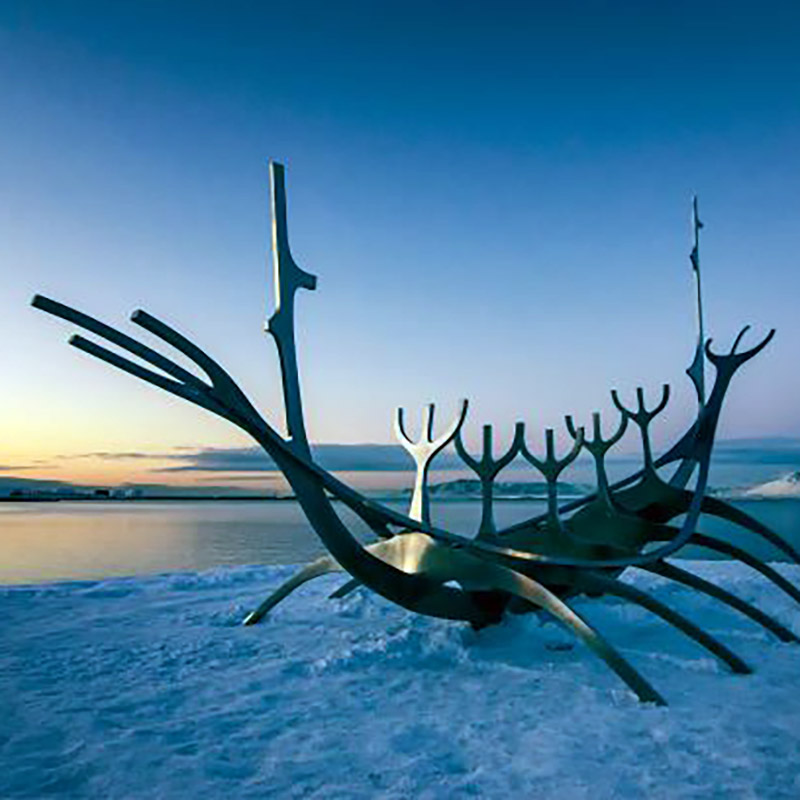On June 17th every year Icelanders mark the 1944 foundation of their republic and independence from Danish rule. The day also happens to be the birthdate of Jón Sigurðsson, the leader of the Icelandic independence movement and the face that adorns the 500 ISK note.
William Valgardson is an Icelandic-Canadian fiction writer and poet. He posted this remarkable article for Icelandic Independence Day:
It’s June 17th. So, most people would say. So what? For the people of Iceland and the Icelandic Canadian and Americans, it is Icelandic Independence Day.
We all know about the Vikings. Those guys raiding coastal communities, carrying of everything they could carry, including winsome maidens. Hollywood keeps making movies about them, just like it keeps making Westerns. Neither have much connection to reality.
The Icelanders weren’t the only Vikings. They were part of the Viking world—there were the Norwegian, Danish, Swedish Vikings. Iceland has never had a large population. There’s very little soil, probably about one percent of the island, a lot of volcanic rock, glaciers, active volcanoes, rivers that range from hot to freezing cold. The only crop once the world climate cooled a bit and created the Little Ice Age was grass. Before that, they had managed to grow some grain. The result was that they became herders, raising sheep, dairy cattle and horses. They also fished but since they didn’t have decked boats, they didn’t go far from shore. You can see why they were enamored of the idea of dropping in on monasteries and coastal villages and helping themselves to whatever was available.
However, the Viking era didn’t last long, 793-1066. In the 13th C. the Norwegian king took over because the Icelanders had weakened themselves fighting with each other. Then conflict among Norway, Sweden and Denmark meant that Iceland ended up under Danish rule.
The Danes tried to make a buck or two from Iceland. They set up a trade monopoly in the 17th and 18th centuries. The Icelanders didn’t have much in the way of trade goods. They were sitting on a rock in the North Atlantic, the weather turned cold and colder and filled the harbours with ice. That meant fishing didn’t bring much of a catch and the grass didn’t grow. Throw in several natural disasters and you’ve got people dying of hunger.
WWI was good for Iceland. The Icelanders were able to sell everything they could produce. They also got paid for their wool and fish and seaweed and whatever else they could scrape up. For a time, they managed to sell Sulphur. They became a kingdom in 1918 but were still under Danish rule. Although resented, the occupation of the island by the Brits and Commonwealth forces in WWII provided a lot of jobs and money. In 1944, the Icelanders said to Denmark we’re going independent and Denmark couldn’t do anything about it as they were occupied by German forces.
Going independent was a big deal. Imagine, centuries of being run by Norway and then Denmark. It wasn’t all bad but it wasn’t all that good, either. That’s why we usually party on June 17. It’s a bit of a wild party in Iceland but here, in North America, it’s pretty tame. We hoist the Icelandic flag, sing or try to sing the Icelandic national anthem, have a potluck, always include some hard fish (dried cod fillets served with butter), some hakarl (deep water shark) hung for a few months. It stinks of piss because the deeper water sharks can’t expel their urine the usual way, so it dissipates through their flesh. Eating some is a traditional challenge and is usually washed down with brennevin (Black Death), a kind of caraway flavoured schnaps, and lots of desserts. Like lots and lots of desserts, the most famous being vinarterta, a seven layer torte that may or may not be iced.
Halldór Laxness, the Noble winning Icelandic writer, wrote a novel, sometimes translated as Christianity Under Glacier, and in it is a housekeeper for the local parish priest (minister, the official religion is Lutheran. That goes back to those Norwegians. I’ve been told that my family goes back to one of the seven sons of the last Catholic bishop in Iceland. He and his two youngest sons were beheaded. Iceland was a hardship post. To expect a bishop to spend all his winter nights alone was cruel and unjust in the extreme. The church was more flexible and reasonable in those days.) spends every day making cakes and pressing them on the young narrator. From that came the saying that a good hostess had seventeen different desserts on her table.
We’re all related. How could it not be? With plagues and starvation and volcanic eruptions and Turkish raiders seeking slaves, the population was often reduced to such small numbers that at one time the Danes proposed moving everyone from Iceland to Denmark. You’d think that the Icelanders would have jumped at the chance but no, being at least as stubborn as Scotsmen, they said no, they’d rather suffer on their own little rock. Laxness wrote about that, too, in Independent People, his Nobel winning novel. Too stubborn for their own good.
This Covid virus is a pain. June 17 is a big day for us. It’s a day for getting together, eating together, singing together, talking together. I hope it mutates and disappears, becomes something we can stomp on and stomp out.
————————–
W. Valgardson’s latest book is a novel, In Valhalla’s Shadows. It can be ordered from Amazon or through [email protected]

